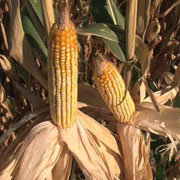VOA标准英语2012--Cutting Ethanol Subsidy Might Not Impact Food Prices
搜索关注在线英语听力室公众号:tingroom,领取免费英语资料大礼包。
(单词翻译)
Cutting Ethanol Subsidy1 Might Not Impact Food Prices
With the U.S. ethanol industry consuming about a quarter of the nation’s maize2 crop, many have blamed biofuels for rising food prices in recent years. The new year brought the end to a $6-billion subsidy supporting the industry, but that doesn't mean food prices will drop because of it.
Hereford Renewable Energy in the Texas Panhandle region is one of 200 plants across the country producing ethanol fuel from maize, which is called corn in the United States. Reagan Howell runs the plant. Before this job, he ran an oil refinery3.
“Honestly, I had not followed the price of corn until I got into the ethanol industry,” Howell says.
But with corn-based ethanol making up 10 percent of most gasoline in the United States, it is one of several factors pushing up the cost of food, according to Purdue University economist4 Wally Tyner.
“Ethanol is a driver of corn prices and has helped to pull up corn prices and all the other agricultural commodities because they are all linked,” he says.
In the United States, higher commodity prices have helped raise the cost of meat and dairy because livestock5 feed costs more. But the impacts have been felt most strongly in developing countries that depend on imported food.
 |
| Corn-based ethanol makes up 10 percent of most gasoline in the United States, which helps push up the cost of food. |
Last year, with Congress under a mountain of debt and looking for budget cuts, a $6-billion subsidy supporting the ethanol industry looked like a prime target.
“It is expiring. And I give the ethanol industry great credit for allowing it to expire,” says Bob Dinneen, head of the Renewable Fuels Association, an ethanol industry trade group, who says he didn't fight to extend the subsidy because the industry has matured. “We never wanted to be tied to the taxpayer6 forever, and I think it is great that we are at a point where it has done its job. We are moving on.”
But experts say the main reason the industry has reached this point is not the subsidy, but rather a 2007 law aimed at increasing domestic production of renewable fuels including ethanol.
The law requires gasoline makers7 to blend renewable fuel into their products. Texas plant manager Reagan Howell notes ethanol is basically the only option.
“We are legally obligated to make ethanol," says Reagan Howell of Hereford Renewable Energy. "It is the only renewable fuel that is commercially viable8 right now.”
Gasoline makers will be legally obligated to use 50-billion liters of ethanol this year. That will use up more than a quarter of the U.S. corn supply, says Purdue’s Wally Tyner.
“We are not going to see a big change in food prices due to the elimination9 of the subsidy, because the driver of the policy today is the renewable fuel standard. That stays.”
Some advocates want to relax the renewable fuel standard until corn supplies are larger and less vulnerable to ethanol’s impact. But with oil prices high, gasoline makers will likely continue to find it profitable to add ethanol.
Though there is more to high food prices than ethanol, the competition between fuel and food is likely to continue.
 收听单词发音
收听单词发音 




